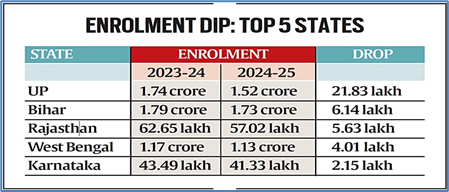Why in News?
- The Ministry of Education (MoE) has flagged a steep decline in enrolment in government and government-aided schools at the primary and upper-primary levels across 23 States and UTs in 2024–25.
- This has prompted the MoE to seek investigation and remedial action from the affected States.
What’s in Today’s Article?
- PM-POSHAN Scheme Overview
- Major Findings from the PM-POSHAN Review Meetings
- Reasons Behind the Decline
- Declining Coverage Under PM-POSHAN
- Other Reports Showing Similar Trends
- Way Ahead
- Conclusion
PM-POSHAN Scheme Overview:
- PM-POSHAN (Pradhan Mantri Poshan Shakti Nirman): Formerly known as the Midday Meal Scheme.
- Target group: Children from pre-primary to Class 8 in government and government-aided schools.
- Objective: Address child nutrition, enhance school attendance, improve learning outcomes and attention spans.
- Funding pattern: Centre and States share cost in 60:40 ratio; Centre provides foodgrains.
Major Findings from the PM-POSHAN Review Meetings: States with largest enrolment decline

Reasons Behind the Decline:
- Data cleansing and methodological changes:
- Shift from aggregate school-wise data to student-wise reporting (includes name, address, Aadhaar details) led to the removal of “ghost” entries, revealing more accurate figures.
- Shift to private schools: Post-COVID reversal of enrollment trends - students shifting from government to private schools, possibly due to parental preferences for better quality education.
Declining Coverage Under PM-POSHAN:
- States with major drops in meal coverage:
- Uttar Pradesh: Dropped by 5.41 lakh
- Rajasthan:3.27 lakh
- West Bengal: 8.04 lakh
- Delhi: 97,000
- Delhi’s underperformance:
- Midday meal coverage in 2024–25 -
- Balvatika (pre-primary): 60%
- Primary: 69%
- Upper primary: 62%
- All below the national average.
- Concerns raised:
- In some States, students bring their own tiffins.
- MoE has instructed States to ensure meal quality and universal coverage.
Other Reports Showing Similar Trends:
- The UDISE+ report (2023-24) revealed an overall drop of 1.5 crore in school enrolment (both government and private) compared to 2018–19 to 2021–22 averages.
- The PM-POSHAN review meetings show that the downward trend continues into 2024–25.
Way Ahead:
- Robust digital infrastructure for real-time monitoring of school data, ensuring transparency and elimination of ghost beneficiaries.
- Integration of PM-POSHAN with broader health and education initiatives, such as POSHAN Abhiyaan and Samagra Shiksha, to create holistic child development ecosystems.
- Community-driven models involving local panchayats, SHGs, and school management committees to build trust in public education.
- Public-private partnerships (PPPs) to enhance infrastructure, nutritional standards, and pedagogical quality in government schools.
- Incentivising enrolment and retention, especially in socio-economically vulnerable areas, through targeted scholarships, nutritional add-ons, and quality education interventions.
Conclusion:
To address the worrying decline in government school enrolment and PM-POSHAN coverage, a multi-pronged and future-ready approach is essential.
As India aspires to become a Viksit Bharat by 2047, investing in foundational education and child nutrition must remain a top priority. This will be a decisive step toward achieving the goals of SDG-4 (quality education) and ensuring an inclusive and equitable learning environment for future generations.









